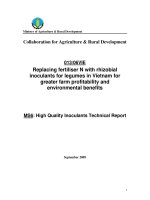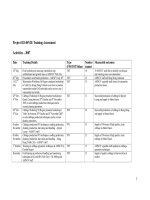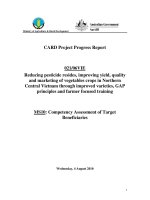Báo cáo khoa học nông nghiệp " Improving traditional integrated farming systems (VAC) – a new livelihood option for poor farmers in the coastal communities - Milestone 5 " ppt
Bạn đang xem bản rút gọn của tài liệu. Xem và tải ngay bản đầy đủ của tài liệu tại đây (714.59 KB, 15 trang )
1
Ministry of Agriculture & Rural Development
Collaboration for Agriculture & Rural Development
Milestone Appraisal Report
027/07VIE
Improving traditional integrated farming systems
(VAC) – a new livelihood option for poor farmers in
the coastal communities
Milestone 5: Status report on the establishment of three improved VAC
systems
September 2009
2
1. System design
In the first year of the project, three (3) households were chosen for demonstration purposes.
These three households were chosen based on various selection criteria which were unique and
representative of the local area. The main features of these three demonstration households were
limited land, high nutrients discharged from animal production system (pigs mainly) into the
existing water bodies, and willingness of the households to adapt new technologies and extend
them to other households. One demonstration household was located in Nghe An (Quynh Luu)
and other two in Quang Tri (Trieu Hoa and Trieu Lang). The new technology incorporated
introduction of a new high-value specie and establishment of a new water recirculating culture
system which is expected to have no discharge into the existing water body (pond). The
discharge (waste) from the new recirculating system is planned to be used in the production of
earth worms, which in turn can be fed to fish and used for horticulture purposes. The water
recirculating VAC fish production system at each household consisted of one culture tank with
biofiltration and waste collection tanks and an associated earth worm house. The proposed
design for each component of the system is shown in Figures 1 - 4.
3
Figure 1: Proposed design for aquaculture system and system housing.
4
Figure 2: Proposed design of earth worm culture system and housing.
5
Figure 3: Proposed design of sediment tank for aquaculture system.
6
Figure 4: Proposed design of biofilter for aquaculture system.
2. Establishment and operating costs and aquaculture production status
2.1. Establishment costs (investment)
Initial establishment for the system including tanks for fish, water storage and filtration, is
presented in Table 1.
7
Table 1: Establishment costs of demonstration system at each household (I - III).
No Date Content Cost (VND)
I
Quynh Luu – Nghe an
1 9/9/2008 Cement, steel 5,310,000
2 20/09/08 Palm leaves, bamboo 5,193,000
3 12/10/2008 Brick, stones, concrete columns 8,940,000
4 12/10/2008 Labor and electricity 10,200,000
5 26/08/08 Well and install device for pump 3,100,000
Total 32,743,000
II
Trieu Hoa - Quang tri
1 28/8/08 Brick, sand, stone, wood and bamboo 9,158,000
2 29/8/08 Cement, steel 5,625,000
3 14/10/08 Labor and electricity 9,850,000
4 14/10/08 Cement Piro, nail, top brick 5,433,500
5 12/9/2008 Cost for well 1,500,000
Total 31,566,500
III
Trieu Lang - Quang tri
1 28/8/08 Brick, sand and stone 7,200,000
2 29/8/08 Cements and steel lines 5,350,000
3 14/10/08 Labors 7,750,000
4 14/10/08 Cement pipro cement nail, top brick 5,433,500
Total 25,733,500
Total for three systems 90,043,000
2.2. Operational cost
Operational costs for the systems include; the electricity required for pumping water, fingerlings,
feed, probiotics and labor. The largest proportion of the cost is feed (trash fish or earth worms).
Trash fish is relatively expensive and is an unreliable source of food. The operational costs of the
system established at each demonstration household are outlined in Table 2.
Table 2: Operation cost of the three demonstration systems.
Cost (VND)
Items
Quynh Luu –
Nghe an
Trieu Hoa –
Quang tri
Trieu Lang-
Quang tri
Pump (electricity) 56.000 18.200
Fingerling 13.140.000
Feed
Probiotics
Labor 3.200.000 2.080.000
Total
8
2.3. Production status
Initially two systems (Trieu Long and Trieu Hoa) were stocked with eels (Anguilla mamorata)
and one (Quynh Luu) with snake head (Channa channa). However, as a result of poor fingerling
quality, all eels in the Trieu Hoa system died one month after stocking the tank. The system was
subsequently restocked with snake head.
The production status of the Quynh Luu and Trieu Hoa systems in 2008 is outlined in Tables 3
and 4.
Table 3: Production status of the Quynh Luu (Mr Tung) system.
QUYNH LUU Amount
Days of culture
80
Total of fish 124
Average weight (g)
232
Total weight (g) 28768
Daily Feeding (kg) 2.5
Total feed used (kg)
200
Amount for feed (VND) 800000
Pumping cost (VND)
56000
Pumping time/day (hr) 1
Electricity cost /unit (VND)
700
Gross profit (VND)
12945600
Table 4: Production status of the Trieu Hoa (Mr Thieu) system.
TRIEU HOA Amount
Days of culture
52
Total of fish 6000
Average weight (g)
18.6
Total weight (g) 111600
Daily Feeding (kg) 5.5
Total feed used (kg)
286
Amount for feed (VND) 1430000
Pumping cost (VND)
18200
Pumping time/day (hr) 0.5
Electricity cost /unit (VND)
700
Gross profit (VND)
6696000
9
3. Assessment of recirculating (closed) production system and levels of
nitrogenous waste
The water quality parameters of the Trieu Hoa and Quynh Luu systems are shown in Tables 5
and 6. Tank system included a biofilter and therefore, a lower level of nitrogenous waste was
expected in these systems when compared to the ponds which did not include any filtration
systems.
Table 5: Water quality parameters for the system in Trieu Hoa. (tank water is treated
(biofilter); pond water is untreated)
20/11/08 29/11/08 7/12/2008 25/12/08
Parameter Pond Tank Pond Tank Pond Tank Pond Tank
Water temp. (
o
C) 24.4 23.6 24.2 23.4 23.2 22.1 23 20.1
pH 8.02 7.82 8.05 7.78 7.89 7.87 8.1 7.85
DO (mg/L) 6.45 4.34 7.43 4.75 6.78 4.54 5.67 3.55
AlK 80 80 78 80 80.2 80 79 81
Hd H 6.7 6.5 7 6.6 7 6.5 7.3 6.7
Total Ammonia (mg/L)
1.01 0.15 1.05 0.2 0.95 0.25 1.03 0.3
NO
2
(mg/L) 0.4 0.25 0.35 0.2 0.35 0.2 0.45 0.15
NO
3
(mg/L) 1.25 0.7 1.1 0.55 0.85 0.5 0.95 0.45
PO
4
(mg/L) 0.05 0.05 0.1 0.04 0.06 0.05 0.15 0.45
PO
4
total (mg/L) 0.16 0.15 0.2 0.2 0.15 0.2 0.25 0.1
Table 6: Water quality of tank in Quynh Luu system.
Parameter
30/10 14/11 29/11 7/12 25/12
Water temp.(
o
C) 25.7 24.6 24.3 22.3 20.5
pH 7.76 7.78 7.83 7.76 7.82
DO (mg/l) 4.35 3.56 4.32 4.37 4.3
AlK 70 73 80 78 74
Hd H 6.5 6 5.7 6.5 6.6
Ammonia total (mg/l) 0.05 0.05 0.1 0.15 0.25
NO
2
(mg/l) 0.05 0.05 0.1 0.15 0.3
NO
3
(mg/l) 0.25 0.32 0.35 0.42 0.57
PO
4
(mg/l) 0.05 0.07 0.06 0.05 0.08
PO
4
total (mg/l) 0.08 0.15 0.1 0.15 0.25
10
Water parameters were within acceptable ranges for fish health and growth. Examination of dead
fish suggested that the mass mortality of eels one week after stocking was a result of
transportation and poor fingerling quality.
4. Lessons learned for adjustment in design and operation of VAC models in Year 2
• If farmers are not financially supported by the project, it is unlikely that they will be
convinced to invest.
• It must be demonstrated to the farmers that although initial investment is high, proper
design and installation of the system will ensure future profits with minimal maintenance.
• A simple system design is recommended.
• Water supply for the system is generally not an issue.
• Intermittent electricity supply must be taken into consideration for system design and
operation. Alternatively, a generator could be included in the system design however, this
would increase the initial investment and running costs.
• Biofiltration is only required at critical times or when water supply is limited. The supply
water for the system established in Trieu Lang-Quang Tri (Mr. Sinh) is of relatively poor
quality and provides a good example of a situation where biofiltration should be used.
• With the increase of cost for inclusion of biofiltration to the system stocking of a high
valued fish species is recommended.
• Inclusion of a biofilter is most suitable for systems nursing fry and fingerlings. A biofilter
improves water quality and therefore reduces the risk of pollution and disease outbreaks
which, at present is the bottle neck for the aquaculture nursery industry.
• For some species, such as snake head, a filtration is enough to maintain high growth rate
of the fish. (Binh, is this supposed to say ‘no’ filtration…?)
• Eels may not a suitable species as;
i. fingerlings are collected from the wild which is no longer sustainable, and
ii. method of collection (electric shock or bait-hook fishing) generally leads to
damaged stock and/or high mortality.
11
5. New VAC Guidelines Manual
Conditions applicable to the improved VAC system;
• Suitable for farms where ponds are non-existent or, exist but are of an area less than
200m
2
particularly in areas of limited access to water,
• Availability of raw materials (eg manures from cattle and/or poultry in the area),
• Suitable for culture of fresh and brackish water species
• Recommended for high value species
Table 7 outlines the system requirements for each species.
Table 7: Species and culture conditions
Species System requirements
Snake head • Cement tank (area = 5 – 40 m²; height = 60 – 70 cm,
surrounded with net)
• Suitable for farms without ponds and unskilled farmers.
• Feed with earth worms or trash fish
Goby fish • Cement tank/ponds (area= 5 – 40 m²; height = 60 – 70 cm)
• Salinity 0 – 12%
0
• Feed with earth worms or trash fish
Grouper • Cement tank/ponds (area= 5 – 40 m²; height = 1.2 – 1.6 m)
• High quality of water (especially DO and BOD)
• Bio-filter
• Feed earth worms or trash fish
Fry/Fingerling nursing
• Cement tank/ponds
• Bio-filter is recommended as the production cycle is short (ie 2
– 8 weeks depending on species)
• Feeding with earth worms is recommended
6. Design and operation
The actual design and operation of the three improved VAC systems installed at each of the three
locations are outlined below. Technical notes for the successful culture of earthworms are also
included.
6.1. Aquaculture system
12
13
14
6.2. Earth worm culture
The initial step to establish an earthworm culture is to add a few egg-capsules or worm “seeds”
to a culture medium of earthworm food in some kind of container or bed (eg a tin can, a small
wooden box, a compost heap, or a specially designed culture bed). The culture must be kept
moist and shaded.
6.2.1. House
• Rearing container area should be 20 – 30 m², depending upon the local situation.
• The rearing container should be located at a distance of 50cm from the house wall.
• House wall should be made of bamboo, or jute materials
• The vertical frame of the house should consist of concrete columns while the horizontal
frame should be made of bamboo.
• The suggested material for the roof of the house is palm leaves. Piro or plastic are other
suitable options.
6.2.2. Culture technical notes
• Available sources of culture medium include cattle and poultry manures and by-products,
such as straw plant wastes from agriculture.
• Rearing container
15
Containers should be in a suitable and convenient location that is, close to manure, away
from strong and direct sunlight and in an area not prone to flooding.
The container floor plays an important role in maintaining the quality of the culture
medium. It is suggested that the floor should be made of cement-sand or plastic to
maintain moisture, protect from ants and protect from external water sources that may
lead to water logging.
• Temperature
The range of temperature should be between 20
o
C - 30
o
C. When temperature decreases in
winter, grass or banana leaves can be applied to cover the surface to maintain temperature
and prevent mass mortality. Light can be applied to increase temperature.
• Moisture
High moisture content of the culture medium is required for optimum growth so regular
spraying of containers with water is recommended. When ambient temperature is high,
spraying of the culture medium should occur at least two times per day.
• Light
Cultures should be protected from sun light. In areas where total avoidance of sunlight is
unfeasible sedge mat, straw, or leaves can be used to cover the container surface.
However, well ventilated conditions surrounding the culture should be maintained.
• Gas
CO
2
, H
2
S, SO
3
, NH
3
are particularly toxic. Earthworms are highly sensitive to NH
3
from
urea waste and thus manures should be treated before use.
• Food
2 kg of worms requires 1 – 2 kg manure (wet weight) daily. Manure can be sourced from
cow, buffalo, goat, pig, duck, chicken, straw or other organic materials. Fresh manure
from cow or/and buffalo is highly recommended. Before using any type of manure as a
food source, ammonia should be at least partly removed.
A recommended diet/culture medium for earthworms includes 50% straw, sugar waste,
sawdust; 20% plant by-product; 30% manure from either cow or pig.









